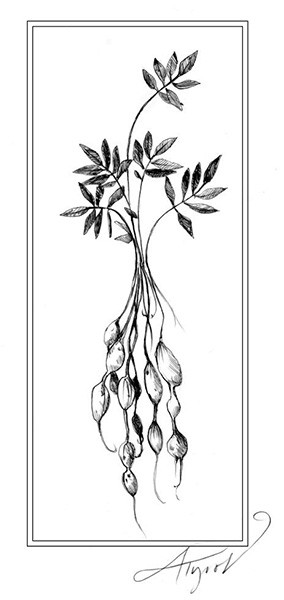
This time of year, squirrels and chipmunks are rushing to fill their winter larders with seeds and nuts, often loudly squabbling with each other. It’s harvest time in the woods, and not just for mast falling to the ground. Apios americana – the groundnut – is in its prime, but you’ll need a shovel for this treat.
But first things first: groundnuts are legumes, not nuts, explained Ed Klekowski, biology professor at the University of Massachusetts, Amherst. Botanically speaking, a nut is a seed enclosed in a hard shell that does not open to release the seed (think acorns). The “nut” of the groundnut is an underground tuber, which, although it has a nutty flavor, has no shell and can be boiled and buttered for dinner (now think potato).
I first came across the Apios americana a few summers ago while hiking along the Ompompanoosuc River in Vermont. Tucked within a tangle of riverside vegetation were sweetly scented white and maroon flowers. They were spaced along twisting vines that held tight to other plants. The flowers – with their intricate folds and prominent keel – were clearly of the pea family. But it wasn’t until I looked in my field guide at home that I realized the plant’s real treasures were underground. If I had dug down just a few inches beneath the soil, I would have unearthed bulbous swellings growing along the thin, woody roots of this plant. While these tubers typically range in size from a grape to a walnut, they can grow as big as a russet potato.
Groundnuts – also called Indian potatoes, wild beans, and hopniss – have a long history in the eastern United States. They were a large part of the diet for Native Americans as well as European settlers. Like potatoes, groundnut tubers keep well once dug, and therefore provided an important cold weather staple.
As a food, groundnuts are impressive. Not only do they overwinter well, they are chock full of protein – about three times as much as your average potato. And like potatoes, they can be peeled, boiled, fried, buttered, and salt-and-peppered.
Some notes of caution: eating them raw is not recommended, because of the risk of soil bacteria contamination. Also, groundnuts cause an allergic reaction for a small number of people. According to Sam Thayer, author of The Forager’s Harvest and Nature’s Garden, “it is common for legumes to cause such reaction (common relative to other plants) and the culprit is almost always a protein.” While Thayer added he does not have statistics on groundnuts as an allergen, he has heard stories – one to two every year – of a person getting sick from them. He said he eats groundnuts with no problem, as do members of his family. (Tom Seymour, author of several foraging books including Foraging New England and the blog, Wild Plants and Wooly Bears, advises anyone eating a new, wild food to sample only a small amount at first.)
While you can harvest these tubers any time of year, the best time is now, after a frost or two has sweetened them but still early enough that the ground remains easy to dig. Before setting out to look for groundnuts, pack your field guide, as there are other viney plants out there growing in the same habitat, such as the hog peanut (which also has edible tubers) and poison ivy (which surely you do not want to try digging up). Head to an area of moist woodlands or low, thicket-like vegetation along water. I’ve always found groundnuts along rivers. Since the flowers are usually gone by this time of year, look for the vines, which can grow over ten feet long and will be wrapped and twisted around the stems of any surrounding plants. The alternate leaves are four to eight inches long, and usually have seven leaflets, each about two inches long.
Once washed, the tubers’ skin can be peeled off using a potato peeler or knife. Then it’s the cook’s choice: groundnuts can be sliced up and fried in oil or bacon fat, boiled and buttered, or added to soups or stews.
Groundnuts have a mild nutty flavor that can be quite scrumptious. While I won’t be substituting mashed groundnuts for mashed potatoes this Thanksgiving, I do recommend giving these wild tubers a try.


Discussion *